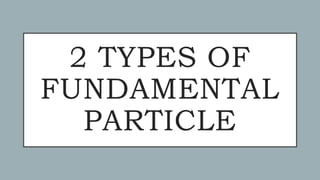
2 Types of Fundamental Particle.pptx
- 2. FUNDAMENTAL PARTICLE It is also called as an elementary particle, a subatomic particle that is not composed of other particles. A particle containing two or more elementary or fundamental particles are what we call composite particles. It has also a goal of theoretical elementary particle physics which is to understand the most fundamental law which govern our universe and to understand the structure and nature of the universe at the deepest level.
- 3. QUARKS These quarks are considered as one of the main types of fundamental particles. They are combined to produce composite particles which is hadrons, the most stable of it are neutrons and protons which are components of atomic nuclei. George Zweig (1964) & Murray Gell-Mann (1964) were the ones who theorized its existence. These can’t exist independently but as a constituent part of matter. It describes the unobserved particles.
- 4. 6 TYPES OF QUARK 1. UP Quark – These are the lightest among all the quarks. They have the maximum stability due to the lowest mass. The symbol used is u, its antiparticle is also denoted as u. 2. DOWN Quark – The down quark comes next to up quarks regarding its light mass. Therefore, it has also high stability. It is denoted by d, and its antiparticle is also denoted as d. 3. STRANGE Quark – The third lightest of all. Denoted by s, antiparticle is also denoted as S.
- 5. … 4. CHARM Quark – Its example is meson which is called a J/Psi. Denoted by C, its antiparticle is also denoted by C. 5. TOP Quark – Denoted by t, and its antiparticle is denoted also by t. 6. BOTTOM Quark – It is symbolized by b and its antiparticle is denoted by b.
- 6. LEPTONS These are also subatomic particles that are only influenced by gravitational force, weak nuclear force and electromagnetic force. Leptons are not influenced by the strong nuclear force. Unlike protons and neurons which are held together within the nucleus of an atom that uses strong nuclear force, leptons use weak nuclear force. Its Greek word leptos means small, subtle, delicate or threshed out. Began to be used in 1948.
- 7. TYPES OF LEPTON ELECTRON (e) This was discovered by J.J. Thomson in 1897 while he experimented with cathode rays. He was able to determine that cathode rays were actually comprised of subatomic particles with little mass and a negative charge. Since cathode rays were repelled by a negative charge and attracted to a positive charge, they were determined to exhibit a negative charge. The amount the cathode rays were displaced by a magnet allowed him to determine their mass.
- 8. … MUON This was discovered in 1936 by the American Physicists namely Carl D. Anderson and Seth Neddermeyer in determining the cosmic rays that were made up of another member of the lepton group of particles. They were able to determine this by demonstrating the constituent particles of cosmic rays were not affected by the strong nuclear force. It was also determined that muons are unstable and each quickly decays by weak nuclear force into an electron and two types of neutrinos.
- 9. … TAUON (T) This was discovered by a series of experiments conducted by Martin Lewis Perl at the Stanford Linear Accelerator Center (SLAC) which lasted from 1974-1977. The particle’s discovery was anticipated by Yung-su Tsai in1971who theorized how it may be detected. This particle was determined to pretty massive relative to the electron and neuron. Like the muon, tau also decays into other particles.
- 10. IMPORTANCE OF FUNDAMENTAL PARTICLE Enables a picture to be built up of what matter is and how it works Used in the sense that these so called building blocks are simple and structureless and can’t be made up of anything smaller TO SUM EVERYTHING UP: Many of the fundamental constituents have large masses and require correspondingly high energies for their creation and study. This can be seen from Einstein’s famous equation [E=(m)(c)(c)] read as I EM SI SQUARED
- 11. THANK YOU FOR LISTENING MGA KAPATID, KAPUSO’T KAPAMILYA!!! MEMBERS: Angel Lattao Jhayvhan Carl Ravelo Euneth Mae Garcia April Mie Marie Taccad GROUP FIVE, HIGH FIVE!!!